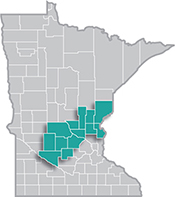 Central Minnesota is a manufacturing stronghold, with several global manufacturing firms operating there.
Central Minnesota is a manufacturing stronghold, with several global manufacturing firms operating there.
The region is especially well known for its expertise in food processing, printing, furniture manufacturing, appliances, machinery and heavy equipment manufacturing.
View our latest blogs on CareerForce. Want the freshest data delivered by email? Subscribe to our regional newsletters.
6/18/2015 10:09:32 AM
Luke Greiner
According to the Minnesota Turkey Growers Association, Minnesota is the number one turkey producing and processing state in the US, raising approximately 45 million turkeys annually. Central Minnesota is pivotal in these production efforts, providing more than 31 percent of turkey inventory and 38 percent of the chicken inventory for the entire state at any given time throughout the year.
The poultry industry - both turkeys and chickens - is visible and critical to many residents of Central Minnesota because it provides thousands of jobs in the region. As such, the H5N2 Avian Influenza is impacting Central Minnesota more than any other region in the state. Through the first week of June, Minnesota has lost almost 8.9 million birds on 107 farms to this virus, and over 61 percent of these losses have occurred in Central Minnesota.

A large complication to this highly pathogenic avian influenza (HPAI) is the relative newness of the strain. The HPAI H5 strain was first confirmed just 6 months ago in December. According to the USDA, the first detection in Minnesota was reported on March 4; since then 23 counties have confirmed cases.
To prevent cyclical viral infections, USDA guidance controls restocking efforts of infected facilities. Once a farm receives confirmation of the virus, the entire site is tested, all bird associated with infected barns are destroyed, and a minimum 28-day composting phase that includes at least two heat cycles begins. Afterward, a 21-day cleaning and disinfecting phase begins, making the combined processes take at least seven weeks. These timeframes, however, are only a starting point and could be longer. All environmental and flock tests must come back negative before a farm can begin restocking. Depending on desired processing weight, chickens take 5 to 9 weeks to reach slaughter size, and turkeys take between 16 and 22 weeks.
The exact impact of the avian flu is not quite clear at the moment because statistics carry a degree of lag time in this rapidly changing situation. Most recent poultry slaughter data from April of 2015 actually show an increase in processing in Minnesota compared to last April - by 16 percent for turkeys and a 2 percent increase for chickens. Although slaughter counts are not limited to birds raised only in Minnesota, it is probable the majority of animals slaughtered in Minnesota are also raised in Minnesota.
The sectors most relevant to the poultry industry shown in Table 1 below illustrate the high concentration found in Central Minnesota. While these industries represent those directly engaged in the poultry industry, many more industries are and will begin to feel the pinch until the outbreak can be managed.

To help provide context, the University of Minnesota Extension did a report in May on the "Impact of Poultry and Egg Production Losses and Poultry Processing Losses Due to the Avian Influenza," which estimated "$113.6 million of poultry production has been lost in Minnesota (through May 11). This does not include the value of future lost production (due to the further spread of the disease or lost production due to barn disinfection and cleaning)."
Contact Luke Greiner at 320-308-5378.